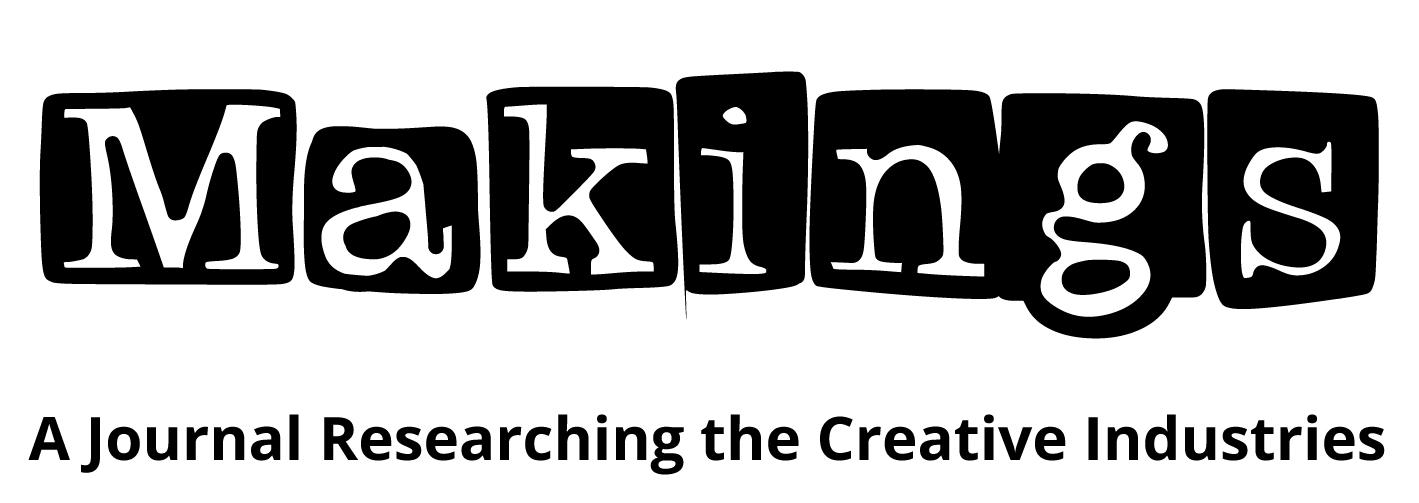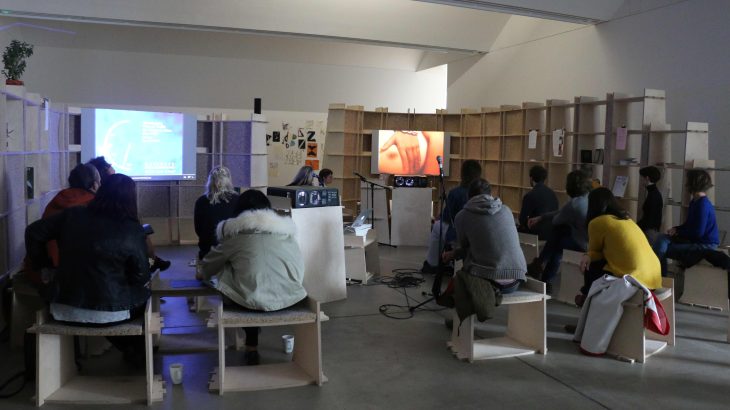
A Polyphonic Essay… on Curatorial Polyphony
Dr Gayle Meikle and Dr Alexandra Ross
Emails: gayle.meikle@newcastle.ac.uk; alexandra.ross@glasgow.ac.uk
In the following article, the authors present their ongoing curatorial project, ‘A Polyphonic Essay on…’, as an example of curating that challenges dominant forms of pedagogy when engaging with time-based artworks. The unfolding discussion will make the particulars of the authors’ ongoing project visible and stake a claim for more conversation-led practices when thinking with artworks and teaching curatorial practice.
Fundamental to curating is the comprehension of how the spatial configuration, atmosphere and interpretation of the art object frames an encounter between artwork and audience. The resultant meaning-making is constructed through the arrangement enacted by the curator, but also the knowledge brought to the encounter by the viewer. The author’s approach to the project ‘A Polyphonic Essay on…’ advocates for a mode of curating time-based artworks which leans into instability and fleetingness within the encounter of the viewer and the artwork, also taken to include the interpretation of and discourse surrounding the work. They do so by holding space for the polyphonic potential of the encounter, acknowledging that the curator has a responsibility to consider the many agencies at play in the constructed situation. In doing so, they will expand the notion of polyvocality in curating whilst arguing for a shift in language towards the polyphonic. The move towards (poly)phony from (poly)vocality enables the curators to acknowledge the many actors and agents at play when encountering artworks, serving to destabilise the authoritative role of the curator in the mediation and interpretation of artworks. By paying close attention to these variables in a live encounter the curators are trialling a way of curating that generates enmeshed, complex, intimate and polyphonic encounters that destabilise hierarchies concerning text, curatorial practices, and canonical presentational modalities often present in the histories of art and exhibition-making. The approach enables the authors to present through practice and in teaching ways of discussing and framing time-based artworks that acknowledge the curator’s role in engendering a nuanced understanding of the artworks and the social and material situation within which it resides.
‘A Polyphonic Essay on…’ began in 2016 and is an iterative practice that presents a live, mediated performance lecture on a clearly framed topic using time-based artworks as the starting point. To date, five editions have been presented: ‘A Polyphonic Essay on Intimacy and Distance’[1] (2016, Transart Triennale, Berlin); ‘A Polyphonic Essay on Memory’[2] (2017, NEoN Festival, Dundee); ‘A Polyphonic Essay on Eros’[3] (2018, BALTIC 39, Newcastle); ‘A Polyphonic Essay on Praxis’,[4] (2020 Glasgow School of Art and the University of Glasgow); and ‘A Polyphonic Essay on Pedagogy and Praxis’,[5] (2021, ELIA Academy, Brussels).
Each edition of the project follows the same pattern. Stage 1: The curators independently commission or select artworks (for two editions the curators selected from a collection and archive) connected to a defined topic, but do not reveal which artist or what artwork have been chosen to the other. In this first stage, the curators also gather sources (texts, websites, audio and video materials) to help develop the conversation around the artworks and topic during the live event. Stage 2: The live presentation begins with the reveal of the artworks to each curator and audience simultaneously. Stage 3: The curators use the pre-gathered source material to contextualise the artworks and invite input and responses from the audience. This stage 3 is akin to sampling from audio visual material such as a VJ and DJ would undertake. A ‘good’ DJ would have a preselected bank of material, but will ‘read-the-room’ as to when to change the tempo to suit the energy of the crowd. The DJ’s ability to use their experience to intuit and direct the atmosphere of a room is mimicked in the way in which ‘The Polyphonic Essay on…’ event progresses. Like a DJ the individual curators draw from the pre-gathered sources to quote, reference and give voice to, in order to support the discussion around the artworks presented in Stage 2. Moreover, the importance of folding in the reception of the work by the audience and their expertise is crucial to opening the conversation beyond the citations collated by the curators. What this looks like in practice, is a lively, referenced discussion that positions the artworks exhibited within scholarly debate, lived experience and other source materials. Inevitably, it may mean that the majority of the materials the individual curators have pre-selected to have at their fingertips, indeed, the keys on their laptops from which they play the audio clips, or the books they have placed tabs highlighting key quotations from which to read, may not be used in the unfolding conversation. The preparation is not wasted; instead Meikle and Ross embrace the uncertainty of the situation understanding that the scholarly knowledge that they bring to the situation is one type of knowledge that enriches the discussion of the artwork and theme.
A crucial component of the performance is simultaneously revealing the full programme to the audience and curators alike. The device introduces uncertainty into the situation and destabilises the control of ‘knowledge’ enacted by the curators. ‘Control’ will be returned to later in the article, but first an understanding of polyphony should be established to ascertain how the project enacts an alternative form of pedagogy.
Polyphonic Encounters
The writing of Anna Tsing helps draw out the use of polyphony when speaking of this ongoing, iterative project. In the following quote, Tsing uses the etymological heritage of the word drawing it back to its connotation in music:
“To appreciate polyphony one must listen both to the separate melody lines and their coming together in unexpected moments of harmony or dissonance. In just this way, to appreciate the assemblage, one must attend to its separate ways of being at the same time as watching how they come together in sporadic but consequential coordinations.” (Emphasis added), (Tsing, 2015: 25).
Tsing emphasises the properties of the unexpected, separate yet together, and the coexistence of harmony and dissonance. In ‘A Polyphonic Essay on…’, the polyphony is generated through the assemblage of things-in-phenomena (Barad, 2003: 817) holding space for dissonance, agreement, repetition, affinity and discord to occur through expanded dialogical practices present in the live mediated event.
Cognisant of the use of the term polyphony in music, the phonic here has the potential to traverse between humans, objects and temporalities, unlike the polyvocal, which one can argue is anthropocentric with its emphasis on the human voice. In museum and heritage studies polyvocality often speaks to the inclusion of multiple subject positions in the communication of the artefact, typically marginalised communities, collection interpretations or audience engagement (Mason et. al. 2013; Schofield et. al. 2018; and Arrigoni and Galani, 2019), thus telling a broader story about the social connotations of the objects in question. When one thinks of ‘phonic’ in the etymological lineage of music, affect is not necessarily delivered through language, speech or sound, but could be interpreted as the phenomenon that is present in the constructed space i.e. the things-in-phenomena. The New Materialist perspective that Barad’s brings to the theorisation of this practice is the attunement to relationality that moves beyond language and discourse to also include materiality. For example, in Barad’s theory of agential realism (2007) Barad introduces “intra-action” to represent the shift from describing agency between entities to causally within each entity. Thus, the boundaries between self, other, human, non-human dissolve: “Reality is not composed of things-in-themselves or things behind-phenomena but ‘things’-in-phenomena” (Barad, 2003: 817). The blurring between the self, other human, non-human recognises that we are co-dependent, affected by and part of the world in which we inhabit. Barad’s way of considering relationality opens up our thinking of how the curating-subject holds space for a drawing close of multiples actors conceptually, experientially and thematically to produce a choral situation (and sometime discordant as per Tsing) in which each part inflects onto the other to continually configure and reconfigure within the live event opening up the potential of a polyphonic understanding of the topic and artwork(s) in question.
The method which is used to produce the polyphonic encounter can be described as a scaffold, first articulated in Meikle’s PhD in 2021. The scaffold describes a set of tactics in curatorial practice that engage an awareness of how the curator, as a bodied presence, reinforces forms of care in curating by balancing the relational qualities of the encounter between artworks and artistic practices with audiences and situations (materially and socio-politically). The curatorial action produces a supportive, partial and in some ways contradictory space that does not assume hierarchies of value.
We shall now shift our voice, our voices – of Gayle Meikle and Alexandra Ross – to harness a key modality of encountering our work; where the potency of the essay -as-form, the voice of the curator and that of our readership shall be addressed. In this article, we are reflecting upon an ongoing process of collaboration, whilst speaking to one another as co-authors and addressing you, our readers, scholars, experts and in some cases friends. We are none of us without each other, and now ‘the authors’ shall become ‘we’.
The Essay-as-from: scholarship and the support of the scaffold
The starting point for the project is our understanding of the essay-as-form (Adorno, 1958), in which Theodor Adorno proposes that the literary format of the essay traverses artistic creativity and scholarly expression whilst remaining fragmentary and changeable. The transposition of the format into a curatorial conceit permits us to negotiate the boundary between scholarship and the mediation of artworks, underscoring interchangeability in our method. In previous writing, we have outlined the components of what we understand the essay-as-form to be, and it is worth recounting here:
“Adorno’s structural attributes of the essay are as follows: all parts of an essay support one another; the essay will begin with the complex and the difficult; the essay reflects the object without doing violence to it; it does not pretend to be beyond mediation; and the essay will not be exhaustive – it will omit and is not totalizing in its system.” (Meikle and Ross, 2017)
The language that we conjure: ‘support’, ‘begin with the complex and the difficult’, ‘without doing violence to’, and ‘it will omit’ not only recognises the partial reading curated projects bring to the understanding of artworks and artistic practices, but also, the interstices of power that inevitably play out in the selection of artworks and mounting of exhibitions. The ‘A Polyphonic Essay on…’ series uses a set of phases (Stage One, Stage Two, and Stage Three) as a stylistic departure from curatorial convention. The reveal of the artworks to the audience and the curators simultaneously (Stage Two) introduce a break in the curatorial paradigm and destabilise the mediated response of presenting artworks to an audience. The curators involved are witnessing the artworks and their situational associations for the first time alongside the audience. The resulting events took shape as a performance, presentation and discussion hybrid, aimed to live-write a mediated experience that involved the artwork, audience, curators and the materials of dissemination as co-writers. Metaphorically speaking the event is the recreation of the imaginative space of the meeting between what is written and the reader. By this we mean that the ‘essay’ is the unfolding action that takes place in the allotted time frame of the event. Those involved; artists, artworks, audience, curators and the materials of mediation are simultaneously co-writers and co-readers in the generation of the essay. Here the scaffolding deployed is the temporal and spatial frame to which we can essay together, the device simultaneously performs as an experiential tool and a disruption of expected curatorial norms.
A Situated Practice: Located in Practices
Contemporary projects, including that of the hybrid performance event ‘And the Moon will set the Time’ by artist Paul Maheke and curator Cédric Fauq (performing at the same time as an earlier ‘A Polyphonic Essay on…’), employ similar techniques of performativity and remixing. Maheke and Fauq collage the situation by circulating the theme of the archival body and how memory and identities are formed using strategies of blackness assembling a series of sources, including other artists’ work popular culture or academic texts, with performative interjections from Maheke. In its live-assembly, this performance lecture nods at its conditions of making and experiments in how we, as audiences, witness performance and performed (black)bodies in a white cube space. Their three-dimensional and temporal collaging is similar to the ‘A Polyphonic Essay on…’ whereby both projects rely on bringing multiple actors and voices into the event whilst acknowledging other influences and positions outside of the encounter. In Fauq and Maheke’s project, they are drawing from their histories and subjectivities, but in a hyper-performed and controlled manner. Whereas, ‘A Polyphonic Essay on…’ fosters liveness, destabilising our authority as knowing subjects in the mediation and presentation of the artworks.
The cultivated permeability between artistic and curatorial practice that ‘A Polyphonic Essay on…’ is located is further supported by projects such as ‘Listening to a listening of Pungwe’ by Memory Biwa and Robert Machiri. Like Maheke and Fauq, method and material are explored through cassette-based domestic and personal archives relating to culture, personal taste, music, the sonic and orality, mixing and remixing, listening and re-listening. The project between Biwa and Machiri thoroughly embraces and borrows from ways of working between and across form, opinion, knowledge and site. ‘Conversations in Gondwana’ by curators Juliana Caffé and Juliana Gontijo provides another articulate example of working beyond the dominance of the English language and its textual tethering compared to spoken forms and oral utterances.
The instability of language through discrete and intimate encounters of personal archives and friendship draws synergies with the conversation-led history of curatorial practice, as Elke Krasny (2020) describes emerging from the salon culture in Berlin and Vienna. This distinctly Jewish, women-led approach cultivated intimacies and dialogue around artistic practice, ideas and politics. Krasny argues that in tandem with the birth of the museum, the salon is an important asset in developing culture and modernity in Europe and the subsequent historiography of curating (Krasny, 2020: 122). ‘A Polyphonic Essay on…’ is not presented in homes or private spaces; instead, it has been presented in a dance studio (2016), an office block dedicated to creative businesses (2017), a white-cube gallery (2019), an online classroom (2020), and an online conference (2021) (Figure 1). The sites in question are somehow connected to ‘The Academy’, sometimes explicitly so, as in the case of ‘A Polyphonic Essay on… Praxis’ enacted in an online classroom environment (Figure 2), with others more tangentially, such as ‘A Polyphonic Essay on… Memory’ (2017). Our focus for the latter edition was the European Women Video Art (EWVA) collection within the REWIND video art archive located at Duncan of Jordanstone College of Art and Design, Dundee, (DJCAD). We aim to create a shared space between artwork, audience, curator and subject in and around ‘The Academy’ that embraces those intimacies prevalent in the salon culture and builds on an ongoing exploration into the space for critical conviviality to occur (Ross, 2014); driven and supported by a porosity of disciplines.
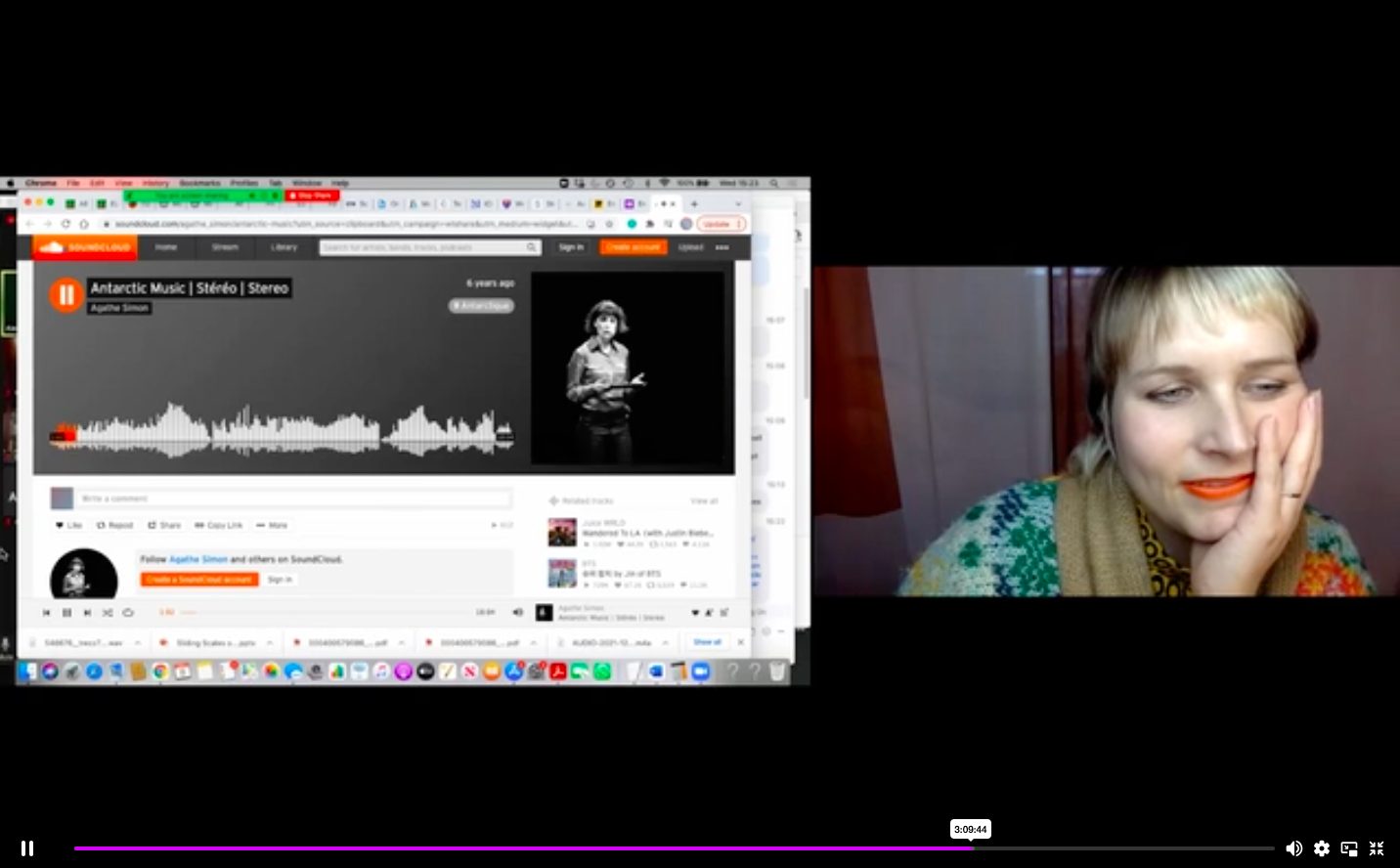
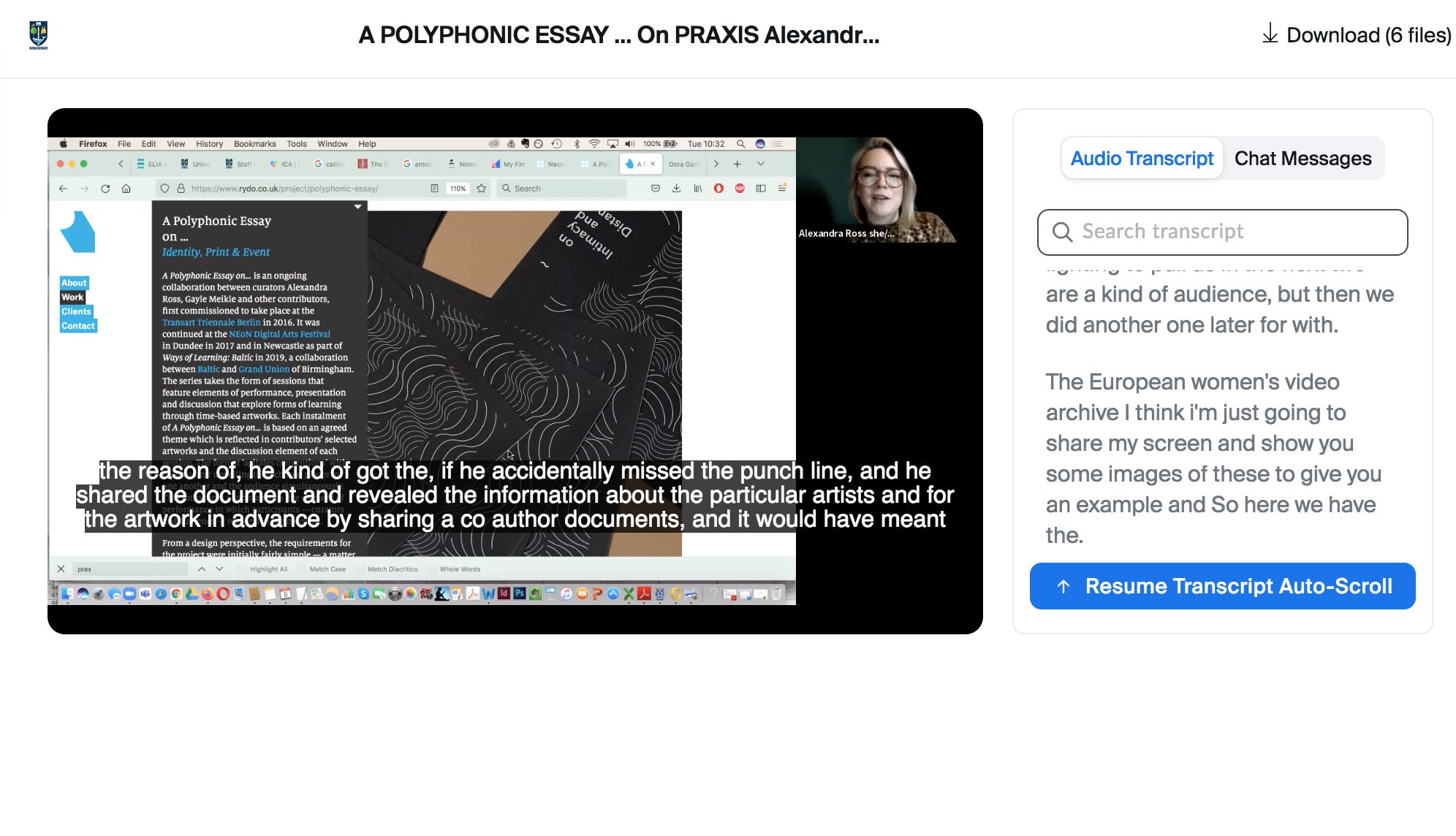
Opening Out: Weaving in Citations, Sources and Voices
On a practical level, a key component to fostering critical conviviality is in the live stage (Stage 3) of ‘A Polyphonic Essay on…’. It is our desire and, indeed, the requirement to create and carve out space for the audience to feel that they are part of the unfolding multimodal conversation. This occurs through implicit and explicit invitations to participate. By revealing the prepared, deeply invested, but unrehearsed/unscripted nature of our presentation, we underscore the manner in which we, as the curators, are undertaking a process of Deep Listening (Oliveros, 2005) alongside each of the them (audience members) and each other (curators). Through this, timing becomes an important consideration. In the first iteration we limited the event to 1 hour 30 minutes. In iteration two we doubled this running time to 3 hours, but had a short interval in the middle inclusive of refreshments. In both editions, each curator was allotted 20 minutes to present artworks. In the second iteration, the break meant we could talk with the attendees to find out more about their experiences and what brought them to the event; in ‘part 3’ of the event we brought the audience into the conversation drawing from those experiences captured over the coffee break (Domela, 2005); whereas, in the first edition of ‘A Polyphonic Essay on…’ we relied on the openness of the audience to interject with their own contributions. In the third iteration, ‘A Polyphonic Essay on Eros’ (Figure 3), we returned to the form of 1 hour 30 minutes, however we introduced a prompt at the beginning of the session, where we asked each member of the audience to say a word that they had a particular affinity with in that moment. by way of an icebreaker. Straight away, this positioned the audience as an active participant in the unfolding mediation. Another strategy, we used for each iteration, was to include clips from relevant artworks of artists living and working in the locale in our audio-bank, weaving the contemporary artistic community of the place in conversation with the practices on review. This attention to the balance of content, timing and conversation is a strategy of care which is deployed through the performativity of the scaffold.
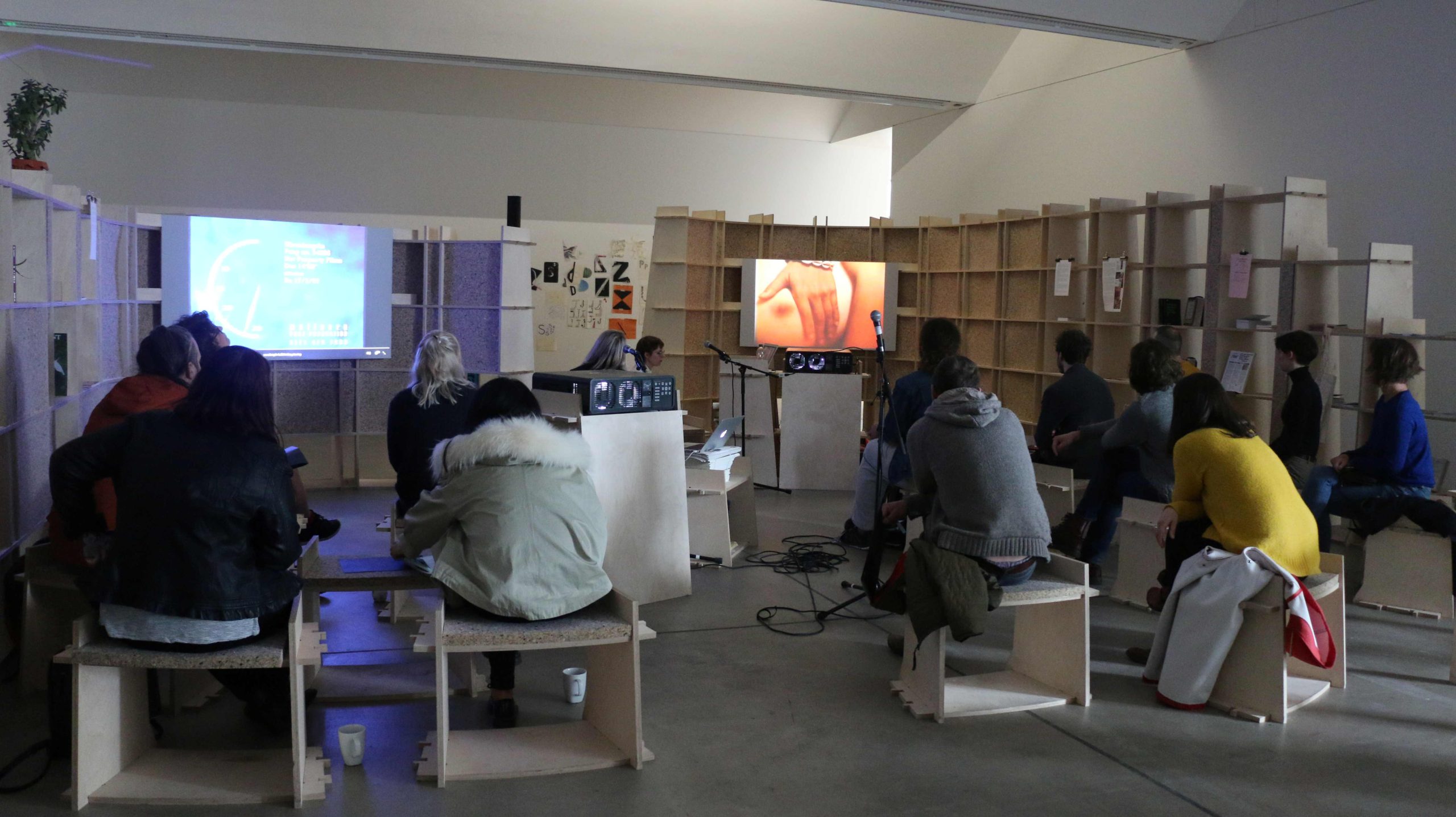
The edition where this porosity was most evident was ‘A Polyphonic Essay on Memory’ through the inclusion of Dr Laura Leuzzi, whose research on and framing of EWVA joined the conversation alongside ours. As such, we divided the room and its staging and the time allotted for screening each of our selected video artworks from the EWVA collection proportionally. Notably, one of the artists included in the research and archive of EWVA, Professor Elaine Shemilt was in attendance in the audience, allowing for critical engagement with the content and form of the works presented and a networked understanding of the entangled nature of the works each of us selected to screen. This layering of conversation, mining down into the artworks and care extended to the practices of each artist selected, was therefore built upon and emulated beyond the three performer-curators (Meikle, Ross and Leuzzi). As such, it was an aural, critical and citational practice that paid sincere attention and care to listening, seeing and understanding the video artworks.
Repeatedly, we have explored how formats of care can work in the cultivation of dialogue. Following Grant Kester’s dialogical aesthetic (2005), we acknowledge a sensibility the curator must imbue to allow for polyphony to occur, that of: “openness, of listening and a willingness to accept dependence and intersubjective vulnerability” (2005: 81). However, Kester’s dialogical aesthetic is placed firmly within the human-to-human relationship in which he is specifically discussing the sensibilities that artists who work dialogically possess. ‘A Polyphonic Essay on…’, on the other hand, welcomes discursivity between subjects, yet is conscious that the social is not divorced from the material in the polyphonic encounter. For example, Figure 4 depicts the moment in ‘A Polyphonic Essay on Memory’ when Meikle was connecting the artwork Women of the Hill, 2015 by Hanna Tuulikki to the themes discussed by Dr Laura Leuzzi concerning her selected video work Transit, 1986 by Antonie Frank Grahamsdaughter, revealing the apparatus used to present the artworks and the other materials and objects present in the room to support the assemblage of the artworks.
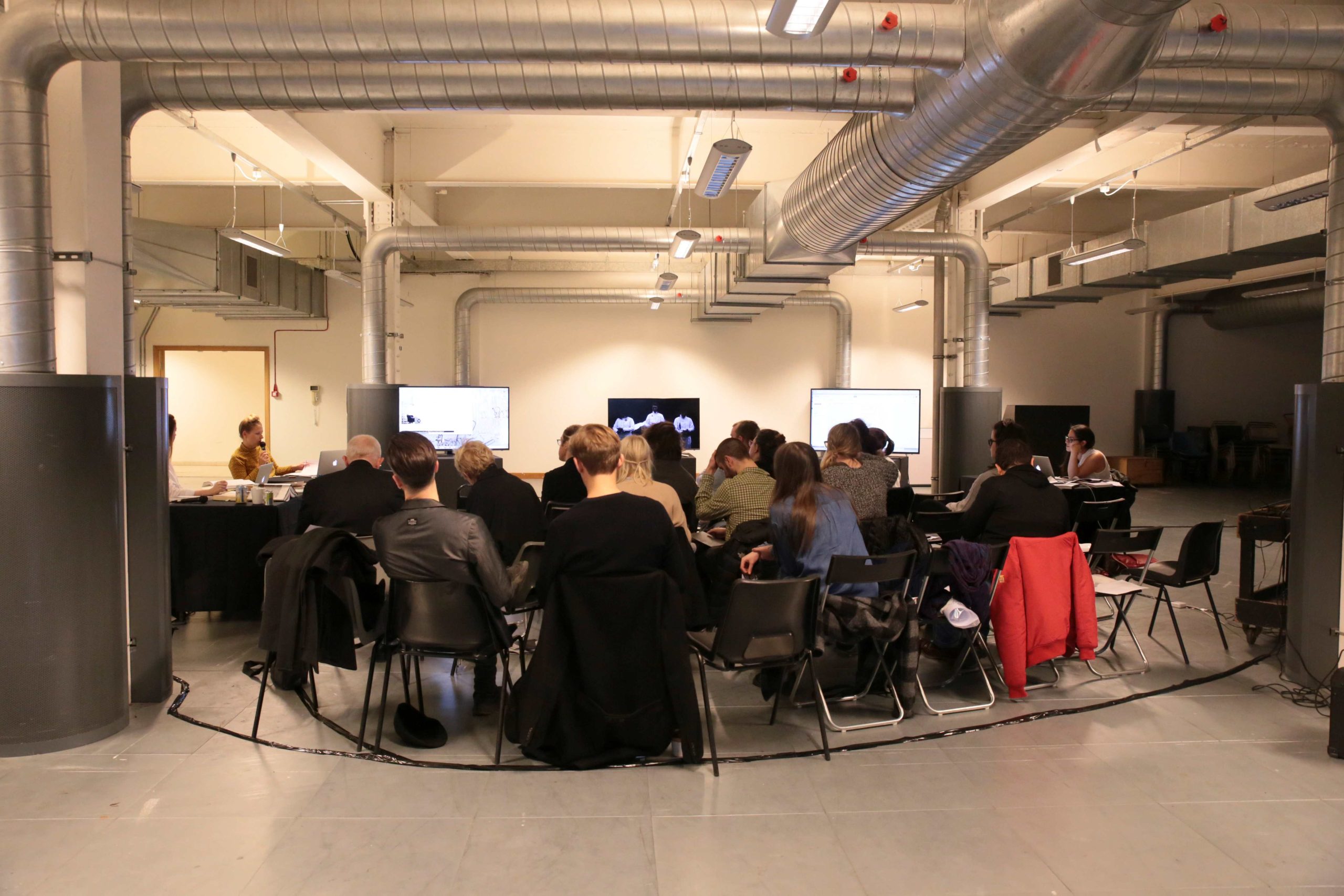
This circularity extended through to our consideration of the configuration of the space by creating a much closer proximity between curator, artwork, and audience than in the first iteration. In ‘A Polyphonic Essay on Intimacy and Distance’, the space was arranged in the traditional end-on configuration of a theatre space (Figure 5). In the second edition, an elliptical arrangement was formed between two pillars in the space. We also presented the artworks on three different screens, thus breaking from the normative convention of screening artworks sequentially on a single screen end-on to the audience. To do this, permission was sought from the artists’ studio, estate and archive, working closely with the archivist Adam Lockhart to maintain the integrity of the artworks.
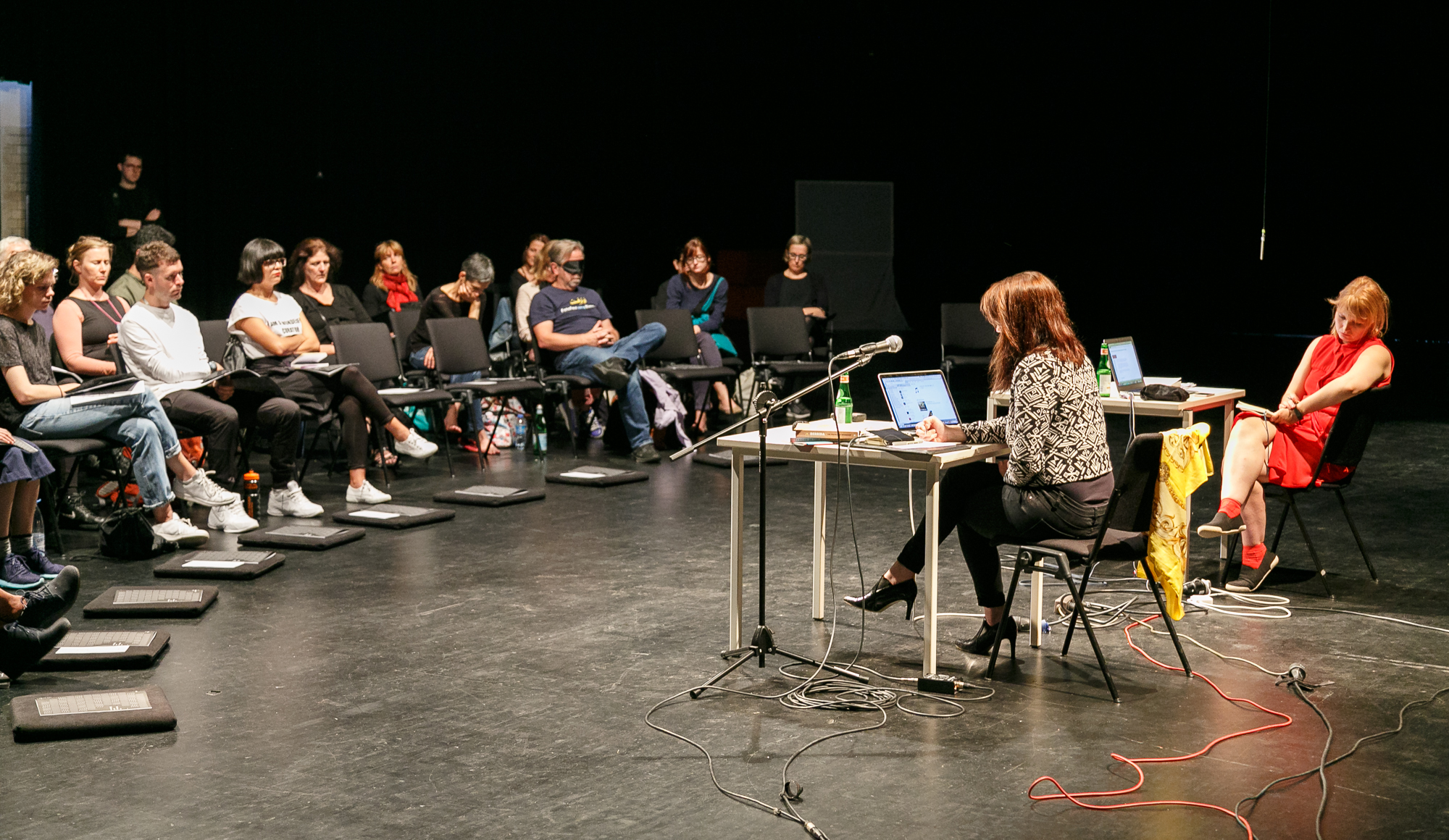
The resulting configuration heightens the association between and utterances of each of the things-in-phenonema that enable the relational encounter to take place. Including, the equipment – without which the audience would not have been able to view and listen to the video works, the sound engineer who operated the sound levels, the separate screens that reveal the presenter’s individual preparatory thoughts, the thought process and action of Leuzzi – who was queuing a response on the screen whilst Meikle was speaking, the audience listening and the pamphlet received on arrival on their seat. The pamphlet makes present the artist and artworks on which we centre the unfolding conversation a critical aide in information sharing due to the novel reveal of the artistic programme at the beginning of the event. All these things matter to how the situation unfolded and have agency to influence or change the proceedings.
A pulling close of bodies, material and environment and the consideration of differing modalities in the curated event engenders a space that can invite an embodied, individual, yet at times, shared and overlapping experience conducive of polyphony. The invitation extended through the gesture of seating configuration and welcome afforded to the audience encourages participation through comfort, configuration and information sharing. Where this differs from more conventional screening practices, and the role of the curatorial, is in the entangled, enmeshed interplay of citations which wrap around the artwork, dually implicating audience and curator, whilst also demanding attentiveness, where the temporal stakes (of time-based works and durational practice) are higher. We seek to engage affect and criticality as we experience the work, rather than disaggregating the work from the critique thereof: a demonstration of and appreciation of the power of praxis.
Concerning Control
In relation to the unfolding conversation of ‘A Polyphonic Essay on…’ we are not levelling ourselves in terms of status – like the ignorant schoolmaster – to erase oneself would be disingenuous to our activity – we are present and have visibility in the process. Instead, we are humbling our status, to acknowledge that bodies bring different ways of affecting and being affected into a situation and that all of these plus the non-human wires, technology, architecture and environment are valued in our study, discourse and understanding of artworks and curating. Our praxis aligns with refusallist curatorial practices as espoused by Lola Olufemi, where she demands that we dismantle, redefine, and in our case, remix, the boundaries and expectations of curating as a space for liveness, experiment, agitation, and porosity (Olufemi, 2021). We set up the situational encounter to relinquish control of the interpretation of artworks and how audiences interface with interpretation of art objects, after all the curatorial is veritably unintentional as intentional (Rogoff and Martinon, 2019).
Let’s think with Braidotti’s nomadic subject here. She builds on Deleuze and Guattari’s imperceptible self and considers this through a ‘bodied subject of memory’ one who moves through time and affects and is affected in the journeying. It is this application of the opposition of ‘stasis’ which is relevant here to our act of scholarship. Locating the collective in the arrangement of material and knowledge and the reliance of each part in the situation in order for the scholarship of the art object to take place.
“A mobile unit in space and time and therefore an enfleshed kind of memory, this subject is not only in process, but is also capable of lasting through sets of discontinuous variations, while remaining extraordinarily faithful to itself.” (Braidotti, 2006:156)
Ever changing but yet ‘faithful’ to itself we can think about the nomadic subject as polyphonic and our attempt at thinking with the situation in which we encounter artworks as scholarly. As curators, we place a fundamental consideration of care in relation to questions around audience(s). The fluidity, configuration and expertise of audiences requires an iterative approach. This approach inherently incorporates reformulating questions around staging, site, content, duration, and choreography. Born from trust, friendship and curiosity ‘A Polyphonic Essay on…’, intersects two overlapping curatorial desires: to challenge conventions of display, and to include multiple voices into the presentation of artworks in order to further the duties of care to which curators should be attending. The space for collective research and learning is one that demands reciprocity as presented in dialogical format with live essaying at its heart. With the rigour of scholastic enquiry, enhanced by sources gathered from a variety of peers – indeed those not conventionally deemed peers within text-centric academic scholarship, this process weaves together and entangles voices both in textual and oral formats, enmeshing them with the presentation of these artworks.
Privileging plurality over singularity, ‘A Polyphonic Essay on…’ is a curatorial intervention into the canon of art history. In doing so, it invites and creates a space for unknowing, not knowing, and learning together and with the artist, the artwork, curators and audience. Why do this at all one may ask? In essence, this is a radical attempt to perform curatorial praxis, and to truly engender a space for learning in all aspects of its staging and experience. No two discussions around the artwork could ever be the same. To state the obvious, art is not made in a vacuum. Art is made by artists in a complex structure of support and at once precariousness. As curators, it is our obligation to pull close to this process and to be supportive and vulnerable, to question and to learn.
[1] A Polyphonic Essay on… Intimacy and Distance (2016) occurred at the Transart Triennale at Uferstudios in Berlin, Germany. Transart is a nomadic postgraduate teaching organisation offering low residency PhD and MA courses in creative arts research. The Triennale is a hybrid of exposition, symposium and peer learning. The organisation invited external practitioners to contribute to a themed programme open to the public and the transart community alike. This edition was commissioned and presented as part of the themed programme. The artists involved were Mohammad Namazi and Koleka Putuma.
Koleka Putuma, who is based in Cape Town. Putuma chose to present a recording of the poem Grief will always ask: Why (2016).
Mohammad Namazi, Internet Fantasy in What Way?, 2016
Participatory sound performance including; mics, sound, internet, participation and smartphone.
[2] A Polyphonic Essay on… Memory (2017) featured artwork by Rose Garrard, Antonie Frank Grahamsdaughter, Tamara Krikorian, Annegret Soltau, Marion Urch and Maria Vedder & Bettina Gruber. It occurred on 7 November 2017 at NEoN Digital Arts Festival, Dundee, UK. For this edition, we partnered with Dr Laura Leuzzi from EWVA (European Women’s Video Art in the 70s and 80s) research project to explore the REWIND archive’s early women’s video art collection.
[3] A Polyphonic Essay on… Eros (2019) took place in the gallery of BALTIC 39 (now Newcastle Contemporary Art) in Newcastle. It formed part of the public programme for Ways of Learning, an exhibition exploring informal learning and communal knowledge developed by Birmingham-based arts organisation Grand Union in association with BALTIC Centre for Contemporary Art, Gateshead. Our contribution to the exhibition was an afternoon event drawing from the collection of Cinenova; a volunteer-run organisation preserving and distributing the work of feminist film and video makers. Cinenova was founded in 1991 following the merger of two feminist film and video distributors, Circles and Cinema of Women, each formed in 1979. The artists involved were Pratibha Parmar and Tran, T Kim-Trang.
[4] A Polyphonic Essay on… Praxis (2021) Online workshop to explore our collaborative engagement with praxis with the M.Litt in Curatorial Practice (Contemporary Art). This is a course jointly delivered between the University of Glasgow and the Glasgow School of Art, convened by Alexandra Ross.
[5] A Polyphonic Essay on… Pedagogy and Praxis (2021) took place as part of ELIA Academy. ELIA is a European network for the development of arts higher education. In this edition, the Academy brought representatives from across Europe to interrogate how arts higher education can destabilise hegemony in the (art) canon and propose more inclusive modalities in arts education. Our contribution took the form of an online workshop mediated through the format of ‘A Polyphonic Essay on…’ . Through a guided engagement with artistic methods developed by artists Lady Kitt and Katherine Bull we introduced polyphony as a central component to producing, mediating and understanding visual culture, arguing for contingency and subjectivity over decisiveness and hegemonic modes of production in the mediation of time-based artworks.
About the authors
Dr Gayle Meikle is a Lecturer in Contemporary Art Curation primarily interested in curating as a creative practice. She teaches across the Fine Art and Media Culture and Heritage departments in the School of Arts and Culture at Newcastle University.
Dr Alexandra Ross is a Lecturer in Contemporary Art and Curation at the University of Glasgow and convenes the M.Litt in Curatorial Practice (Contemporary Art), a jointly run course with the Glasgow School of Art. Her methodology employs a dialogical and conversation-led approach, centring art and artists in interdisciplinary research.
Bibliography
Arrigoni G, Galani A. (2019) Digitally enhanced polyvocality and reflective spaces: challenges in sustaining dialogue in museums through digital technologies. In: Galani A; Mason R; Arrigoni G, ed. European Heritage, Dialogue and Digital Practices. London: Routledge, pp.37-61
Barad, K. (2003). Posthumanist Performativity: Toward an Understanding of How Matter Comes to Matter. Signs: Journal of Women in Culture and Society, 28(3), pp.801-831.
Barad, K. (2007). Meeting the Universe Halfway. Durham: Duke University Press.
Braidotti, R. (2006). The Ethics of Becoming-Imperceptible. In: C. Boundas, ed., Deleuze and Philosophy. Edinburgh: Edinburgh University Press.
Condorelli, C., Wade, G. and Langdon, J. ed., (2009). Support Structures. Berlin: Sternberg Press.
Domela, P. (ed.) (2005). Manifesta Coffee Break: Visual Art and Contemporary Curatorial Work in a Changing Europe. Liverpool: Liverpool Biennial of Contemporary Art.
Hedditch, E. (no date) Circles Social, Title Tours, Luxonline. Available at: https://www.luxonline.org.uk/tours/circles_social(1).html [Accessed: 06 April 2024].
Kester, G. (2005). Conversation Pieces: The Role of Dialogue in Socially-Engaged Art. In: Z. Kucor and S. Leung, ed., Theory in Contemporary Art Since 1985. Blackwell.
Krasny, E. (2020). Archives, Care and Conversation: Suzanne Lacy’s International Dinner Party in Feminist Curatorial Thought. Zurich: ONCURATING.org
Mason, R, Whitehead C, Graham H. (2013) One Voice to Many Voices?: Displaying Polyvocality in an Art Gallery. In: Golding, V., Modest, W, ed. Museums and Communities: Curators, Collections and Collaboration. London: Bloomsbury Publishing PLC, pp.163-177.
Meikle G, Ross A. (2017) Towards a Polyphonic Essay as Form. Else, [online] (2). Available at:
Meikle, G. (2021), Scaffolding: Towards an Erotic Curatorial Method. Thesis. Northumbria University.
Oliveros, P. (2005), Deep Listening: A Composer’s Sound Practice, Deep Listening Publications, iUniverse
Schofield T, Foster-Smith D, Bozoglu G, Whitehead C. (2018) Co-Producing Collections: Re-imagining a Polyvocal Past with Cultural Probes. Open Library of Humanities, 4(1), 35-35
Rogoff, I. and Martinon, J. (2019). Curatorial / Knowledge Introduction | Curatorial / Knowledge. [online] Ck.kein.org. Available at: http://ck.kein.org/introduction [Accessed 6 April. 2024].
Tsing, A. (2015). The mushroom at the end of the world. Princeton: Princeton University Press.
The article draws from several sections from the PhD theses of Meikle, G (2021) Scaffolding: Towards an Erotic Curatorial Method. Northumbria University and Ross, A (2014), Continuous Curatorial Conversations, University of Dundee.
